Estadio G.E.B.A.
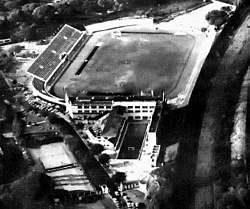 Aerial view of the stadium, c. 1935 | |
| Full name | Estadio Gimnasia y Esgrima de Buenos Aires |
|---|---|
| Location |
Av. Marcelino Freyre 3831 Buenos Aires, Argentina |
| Coordinates | 34°34′3.96″S 58°25′7.78″W / 34.5677667°S 58.4188278°W |
| Owner | Gimnasia y Esgrima (BA) |
| Capacity | 12,000 |
| Surface | Grass |
| Construction | |
| Opened | 1902 |
| Renovated | 1935 |
The Estadio GEBA is a multi-use stadium in the Palermo neighbourhood in Buenos Aires, Argentina. Owned by Club Gimnasia y Esgrima, the stadium is located on the "Sede Jorge Newbery",[1][2] one of the three facilities of the club. Its current capacity is 12,000 spectators.[3]
The stadium was the main football venue during the 1900s and 1910s, having held matches of the Argentina national team and some club matches during that period. The football team of the club (that played in Primera División from 1911 to 1917) also used the stadium for its home games. After the arson of 1916, the stadium was for a time used mainly for rugby union matches. Nowadays, Estadio GEBA is used for music concerts, having hosted a large number of artist performing there.[4]
History
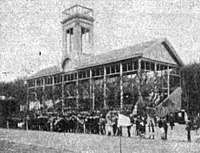
During its first years of existence, the club used facilities such as Sociedad Rural Argentina's venue in Palermo, where athletics competition were held. In 1900 the Municipality of Buenos Aires gave in concession to the club a land that had been used by the Buenos Aires and Rosario Railway (BA&RR). On October 12, 1902, Gimnasia y Esgrima inaugurated its field, built on that land. The field was also known as "Maldonado" due to its proximity to the homonymous stream.[5]

The football team of the club affiliated to the Association (AFA) in 1906, promoting to Primera División in 1910. The stadium was a frequent venue for the squad during its years in Primera, from 1911 to 1917, the year the club disaffiliated from the Association. The GEBA stadium also hosted athletic competitions and rugby union matches, being often used by athletic teams of the University of Buenos Aires.[5]
The Argentina national football team played in GEBA on September 13, 1908, for the Copa Newton v. Uruguay. That match has a historic relevance for being the first time Argentine wore the light blue and white striped jersey, which would be the definitive uniform up to present days.[6] The stadium also hosted the matches where River Plate beat Racing Club by 2–1 before promoting to Primera División for the first time.[7] In 1911, defunct team Alumni played its last game at GEBA on November 26, 1911, when the team beat Porteño by 2–1 winning its 10th. Primera División title.[8] The club would not play any official match again, being dissolved two years later.[9][10]
Due to the small dimensions of the field, spectators often placed under a BA&RR viaduct to watch the matches held in GEBA. The club took advantage of that and built a grandstand just below the viaduct, that was inaugurated in 1909 during a Copa Lipton match between Argentina and Uruguay national teams. Nevertheless, in 1910 the BA&RR dismantled the viaduct to move the tracks. It allowed the club to expand the lateral grandstand of the venue. the stadium was completely refurbished to held the football matches of "Juegos Deportivos del Centenario", sport competitions in commemoration of the Argentince Centennial. A grandstand was built on the side next to the railway. On the side next to Río de la Plata, another one was built while the official grandstand was located on the Maldonado stream side. It consisted in a two-floor wooden structure, similar to the existing in the Hipódromo Argentino de Palermo.[5]
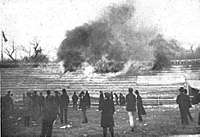
The refurbished stadium hosted two matches of Copa Centenario Revolución de Mayo held in 1910 and considered a predecessor of current Copa América. In 1910, English club Swindon Town played in GEBA some matches during their tour on Argentina where the team also played San Isidro, Estudiantes de Buenos Aires and the Argentina national team.[11] Legendary team Alumni played its last official game (the 1911 championship playoff vs. Porteño) at Gimnasia y Esgrima before being dissolved that same year.[12] Even one of the Superclásico editions was played at GEBA, on May 9, 1915 for the Copa de Competencia Jockey Club.
GEBA also hosted all games of the first Copa America, held in Buenos Aires in 1916.[13] The final between Argentina and Uruguay was attended by more than 40,000 spectators that largely excedeed the capacity of the venue, calculated in 10,000. Because of that, the match had to be suspended. In disagreement with the decision, the angry crowd set fire to the stadium. The match had to be reprogrammed for the next day in the Racing Club stadium. The arson caused a large inactivity for the venue, which would not be reopened until 1918. The club did not rebuilt the fired grandstands, replacing them with a running track[5]
The Argentina national team played its last game at GEBA on October 19, 1919, when the squad won the Copa Premier Honor Argentino after thrashing Uruguay by 6–1,[14] During the 1920s, the venue was still one of the biggest in Argentina, hosting some Primera División matches of both associations, AFA and AAmF. A match between AFA and AAmF was played at GEBA on December 9, 1924, as an attempt to reunificate both associations, although it would not be carried out until 1926. The attendance was higher than expected, largely surpassing the capacity of the field. That was the last football match held in GEBA.[5]
From 1925 on, the stadium mainly hosted rugby union matches. During 45 years it would be the most frequent venue for that sport, with the Argentina national team playing there its international games.
In the middle 1930s, the stadium was completely refurbished, building new concrete grandstands. In 1951, GEBA and Ferro Carril Oeste were the stadiums of the first South American Rugby Championship held in Buenos Aires.[15]
After the 1960s, the Argentina national rugby team started using larger stadiums,[16] such as Ferro Carril Oeste or Vélez Sársfield. Nevertheless, the Estadio GEBA would continue hosting rugby union matches on some occasions, such as the 1993 South American Championship[17] and some friendly matches that same year.[18]
Gallery
 Grandstand built under a railway viaduct, 1909
Grandstand built under a railway viaduct, 1909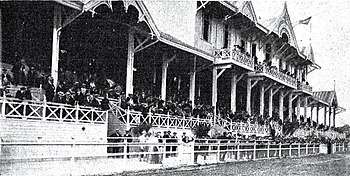 Main grandstand, 1910
Main grandstand, 1910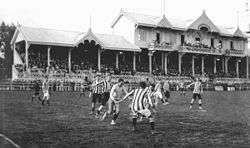 Last match of Alumni, 1911
Last match of Alumni, 1911 Argentina national team v. Swindon Town, 1912
Argentina national team v. Swindon Town, 1912 Running track built after the arson, c. 1920
Running track built after the arson, c. 1920 Concrete grandstand, c. 1935
Concrete grandstand, c. 1935 Argentina national rugby team playing the British Lions, 1936
Argentina national rugby team playing the British Lions, 1936
Music concerts
The club usually rents two of its facilities for concerts and events, being the Jorge Newbery facility the most used for those purposes. Many international artists touring on Argentina have played at Estadio GEBA.[4] A list of artists performing there includes:
- Enrique Iglesias
- Demi Lovato
- Laura Pausini
- Jamiroquai
- Selena Gomez
- Ozzy Osbourne
- Katy Perry
- Julio Iglesias
- Marc Anthony
- Linkin Park
- Jennifer Lopez
- Juan Luis Guerra
- The Killers
- Luis Miguel
- Gloria Estefan
- Duran Duran
- Kylie Minogue
- Morrissey
- Rush
- Muse
- Miley Cyrus
- Lionel Richie
- The Black Eyed Peas
- Big Time Rush
- The Wanted
- Peter Gabriel
- Snow Patrol
- Primal Scream
- System of a Down
- Sepultura
- Nick Jonas & The Administration
- The Strokes
- White Lies
- Beady Eye
- INXS
- Sonic Youth
- Lenny Kravitz
- Noel Gallagher's High Flying Birds
- Rod Stewart
- Alicia Keys
- Bruce Springsteen
- Queen + Adam Lambert
- Alejandro Sanz
References
- ↑ Estadio GEBA at VuenosAirez.com
- ↑ Estadio GEBA at Time for Fun website
- ↑ World Soccer Yearbook, 2002-3: The Complete Guide to the Game by David Goldblatt (2002), published by Dk Pub – ISBN 0-7894-8943-0
- 1 2 "Estadio GEBA sede Jorge Newbery" on Entradasx.com Archived 2012-06-25 at the Wayback Machine.
- 1 2 3 4 5 "El estadio de Maldonado" on Viejos Estadios website
- ↑ Argentine national team archives by Héctor Pelayes on RSSSF.com
- ↑ Racing - River y una muy sospechosa final by Ricardo de Titto on La Nueva.com, 14 Dec 2014
- ↑ Argentina 1911 by Pablo Ciullini on RSSSF website
- ↑ Alumni, Cuna de Campeones y Escuela de Hidalguía by Ernesto Escobar Bavio – Editorial Difusión, Buenos Aires (Published 1953)
- ↑ "Alumni: en el nombre del fútbol" on Clarín, 2003-04-21
- ↑ Argentina national team - List of Other Matches 1901-2008 by Héctor Pelayes on RSSSF.com
- ↑ Argentina 1911 at RSSSF
- ↑ Southamerican Championship 1916 at RSSSF
- ↑ Copa Premio Honor Argentino on RSSSF
- ↑ Un siglo en pequeñas historias by Martín Estévez, El Gráfico, 28 Mar 2017
- ↑ Gimnasia y Esgrima de Buenos Aires y su historia, a Primera by Jorge Búsico, La Nación, 25 Sep 2014
- ↑ Los Pumas hicieron historia, La Prensa, 17 Feb 2004
- ↑ "Argentina at ground: GEBA", ESPN Scrum.com
| Wikimedia Commons has media related to Estadio GEBA. |